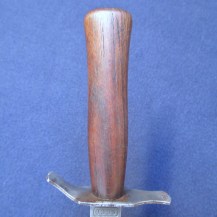French M1916 WW1 ‘Vengeur’ Fighting Knife / Trench Knife by S.G.C.O.
Double edged spear-pointed knife blade, turned wood grip, steel cross hilt. Scabbard of sheet steel with steel belt loop.
This example is stamped ‘S.G.C.O.’ within a cartouche. This is a maker’s mark, most likely referring to the Societe Generale de Coutellerie et Orfevrerie (General Society of Cutlery and Goldsmithing), a manufacturer founded in 1796 which operated the factory at Seychalles Bridge in Thiers from 1902, one of many in the ‘Vallée des Usines’ (Valley of the Factories) which harnessed the river Durolle to drive its machines. This type of knife is often called the ‘Vengeur’ in reference to the more commonly seen stamp ‘Le Vengeur de 1870’, meaning ‘The Avenger of 1870’. This refers to the Franco-Prussian War of 1870, in which the French were badly defeated and lost their territories of Alsace and Lorraine to the Prussians. Memories of this humiliation were clearly still strong in the minds of French soldiers once again defending against German invasion.
Interestingly, the blades on these knives are identical to those used on French-made versions of the US 1918 trench knives. It is likely that French manufacturers produced both types in parallel.
The blade has some light pitting in places but shows no edge damage. The hilt has some patination and is bent downwards on one side – this may well be a period modification to provide more of a guard over the user’s fingers, like that of several German models. The wood grip has its polished finish with one small crack next to the hilt – this is surface-level and the grip remains solid.











